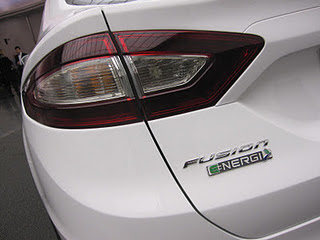To have already a few shows in Detroit, and for discussion with the American journalist B.Diem , it has never been much question of "fuel economy". Even in America, we hear about eco driving and saving energy. The test now is the MPGe (Miles Per Gallon Equivalent) in other words consumption ... Even if the power is never far away. Anyway, even if it is above all a business case is a huge step forward. The best example is provided by Ford, including the new Fusion (the Mondeo in Europe) is the only model to be launched with three energies at the same time (thermal, hybrid and plug-in hybrid).

But apart from this case very symbolic, it is rather the foreign manufacturers that have hosted the show. I propose to talk about the different energies starting with the hybrid.
Mercedes was the event with two new versions based on E-Class: E 300 Bluetec Hybrid a diesel (204 hp, 4.2 L/100 km) and E 400 hybrid gasoline (306 hp, 10.5 L/100 km). The first is for Europe, the second for the American market.
BMW was not left with the Active Hybrid 3, which contains the same ingredients as its big sister of the 5 Series. Ie: the six-cylinder engine Power Twin Turbo 306 HP (the 335i), an electric motor of 55 horsepower and a bonus of 8-speed automatic transmission. Series 3 Hybrid will be equipped with the ECO PRO mode allows the driver to choose between running sports + sports, comfort or economy. It features the recovery of braking energy, the gearshift indicator and many other features to minimize fuel consumption. As Active Hybrid 5, the derivative of the 3 Series will roll over short distances in all-electric mode up to 60 km / h.
In addition, we have seen also the Volkswagen Jetta hybrid, and - best of all - a concept that marks the return of the NSX in Acura (Honda) with a direct-injection V6 coupled to an electric motor.
The Detroit show also marks the arrival of the first plug-in hybrids among "major manufacturers" (Fisker has been the rule)

I have already mentioned the case of the Fusion / Mondeo which uses the technology of the C-Max energy we see in Europe in 2013. But this is not the only example.
Volvo introduced the XC60 example plug-in, which is well suited to the United States. This concept combines a 2 L 4-cylinder turbocharged 280 hp - coupled with a new 8-speed automatic gearbox - with an electric motor of 70 hp (and 200 Nm of torque). The latter is positioned on the rear axle, which can benefit the 4-wheel drive. It is powered by a lithium-ion battery of 12 kWh. With a total output of 350 bhp, the XC60 Hybrid competes easily with the V8 petrol. This explains the reference to T8 on his body.
As his cousin, the V60 D6 (which is a hybrid diesel), this concept offers three driving modes:
- In Pure: an electric mode with a range of 45 km (the EU test cycle)
- Hybrid: when the electric motor assists the gasoline engine, consumption drops to 2.3 L/100 km to 53 g of CO2 per km (again according to the NEDC)
- Power: the XC60 delivers maximum power with 380 Nm of torque and amazing perfs (0 to 100 km / h in 6.1 s)
In addition, this concept introduces a new method of charging the battery (SAVE) in stock. Just press a button to recover enough to make up to 20 km in urban areas.
Toyota, for its part, will launch the plug-in Prius in the course of the year, surprised the world with the concept NS4 prefiguring a new model for 2015. The Japanese automaker wants to reduce consumption by reducing the size and weight of the components of the Hybrid Synergy Drive, while increasing acceleration. The brand also wants to increase the autonomy and power to promote a rapid charge.
In the area of pure electric, the news is dominated by the US launch of the Focus Electric, the imminent release of the Tesla Model S in (the family sedan announced below $ 50 000 and with up to 480 km range) and the commercial deployment of the Chevrolet Volt and Nissan Leaf.

But it is another Japanese who honors the show. The ally of Renault has unveiled a version close to the NV series of 200 electrical future. This van for businesses and families back to the Leaf techno, but offers more space and payload. Note also in the area of electric production version of the Fit EV (electric jazz) Honda for the American market, a concept Hyundai Elantra VE (200 km of autonomy announced) and the surprising E-Bugster of Volkswagen. The German manufacturer has chosen to equip a Beetle with an electric motor developing 85 kW (115 hp) and able to take this two-seater coupe from 0 to 100 km / h in 10 "9 and in silence. At the front and weighing only 80 kg, this engine is powered by a lithium-ion battery located behind the seats, and whose autonomy is 180 km. But do not dream. There is no electric Beetle to the program and the components are those of the e-Golf Blue Motion 2013.
Artikel Terkait:




0 comments:
Post a Comment